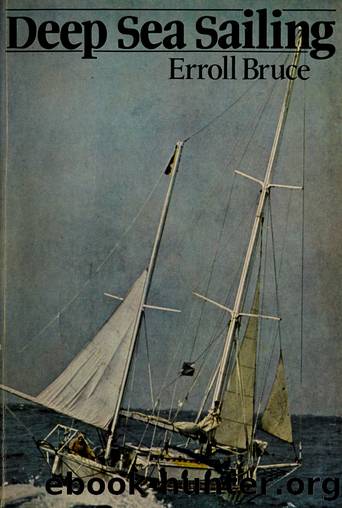Deep sea sailing by Bruce Erroll

Author:Bruce, Erroll
Language: eng
Format: epub
Tags: Sailing
ISBN: 0679508538
Publisher: New York : David McKay
Published: 1978-02-15T00:00:00+00:00
Navigation
Navigation is the art of getting from one place to another. With no more apparatus than a carved coco-nut shell half filled with water, the forerunner of the airmanâs bubble sextant, Polynesian navigators found their way to tiny islands hundreds of miles distant in the Pacific. They did not go straight, they had to wait for exactly the right season, and no record was kept of those that failed to get there.
Sextant.
An improvement on the coco-nut is offered today in the form of the sextant which is a simple but expensive instrument for measuring the angle between two objects. The deep sea sailor uses it to measure the angle between the horizon and the sun, moon or stars. From the observations he takes, the vesselâs latitude can easily be worked out, and if the time is accurately known, the longitude can also be calculated by a process which needs no more learning than the ability to look up figures in a book, add, subtract and write. Observations of several stars, taken within a few minutes of each other, give the most certain position, but stars can only be observed when it is dark enough for them to be visible, yet still light enough for the horizon to show. In practice this works out to short periods at dawn and dusk, which may be reduced, or lost altogether, if the sky is cloudy. Seamen warmly welcomed the idea of the airmanâs bubble sextant, which needed no visible horizon, and they were even more pleased when these very expensive instruments could be bought for a tiny fraction of their cost price as surplus war stores. However, once bought, these soon became surplus yacht stores, as a small craft at sea is too unsteady a platform from which to get even reasonably accurate results with this instrument.
So the ordinary hand sextant is still the main instrument for finding
the position of a small vessel out of sight of land. The operation of the sextant takes a few seconds to understand, but as with a shot-gun, much practice is needed before consistent accuracy is achieved. The first difficulty to be overcome, again like the shot-gun, is holding the instrument level. Although the sextant has a handle which leads almost inevitably to the correct grip, the exact balance of the various muscles will only come when the sextant has frequently been held in this grip. There is no need to wait for the open seas to practise this; it is easy to find a few minutes in harbour, or on a coastal passage, when the right hand can be spared just to hold the sextant. This practice not only assists with taking sights later on but reduces the chance of the instrument being dropped when the sea is rough.
Bad weather sights .
Once this grip becomes habitual there is no difficulty in taking sights well when the sea is calm. In a sea-way, accuracy is more difficult and needs much practice. The first essential is to anchor the body from the waist down.
Download
This site does not store any files on its server. We only index and link to content provided by other sites. Please contact the content providers to delete copyright contents if any and email us, we'll remove relevant links or contents immediately.
The River by Peter Heller(2258)
Breath by James Nestor;(2231)
Sea Survival Handbook by Keith Colwell(2199)
Fatal Storm by Rob Mundle(2172)
Deep by James Nestor(2141)
Lonely Planet Australia by Lonely Planet(2034)
Iced In by Chris Turney(1959)
Discover Australia by Lonely Planet(1906)
Lonely Planet Maldives (Travel Guide) by Planet Lonely & Masters Tom(1800)
One Girl One Dream by Dekker Laura(1639)
Looking for a Ship by John McPhee(1630)
Chicken Soup for the Ocean Lover's Soul by Jack Canfield(1603)
Ten Degrees of Reckoning: The True Story of a Family's Love and the Will to Survive by Hester Rumberg(1601)
Lonely Planet Australia (Travel Guide) by Lonely Planet & Lonely Planet(1551)
South with the Sun by Lynne Cox(1542)
The Wave In Pursuit of the Rogues, Freaks and Giants of the Ocean(1505)
Diver Down by Michael Ange(1471)
Marlinspike Sailor's Arts and Crafts by Barbara Merry(1455)
The Golden Rules: 10 Steps to World-Class Excellence in Your Life and Work by Bob Bowman & Charles Butler(1429)
